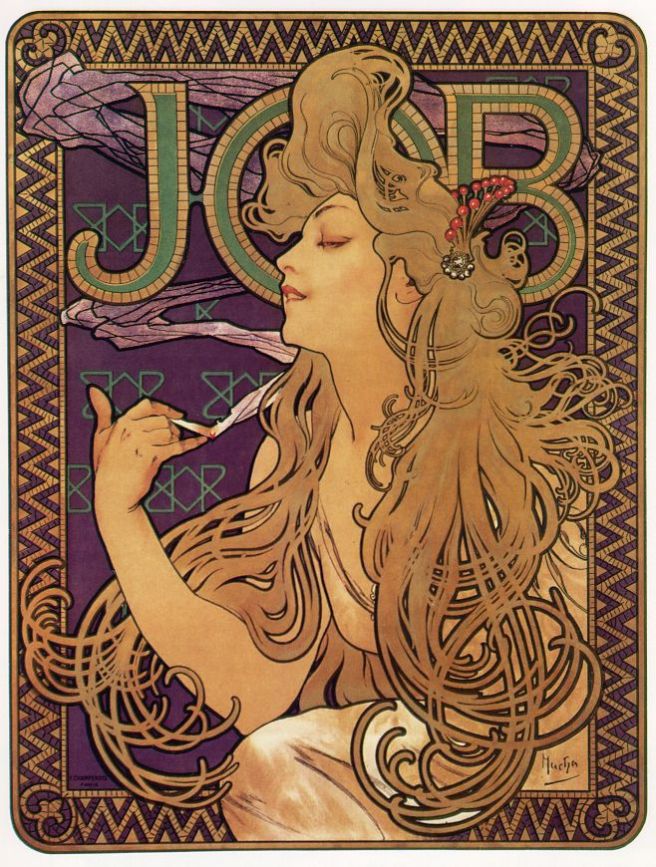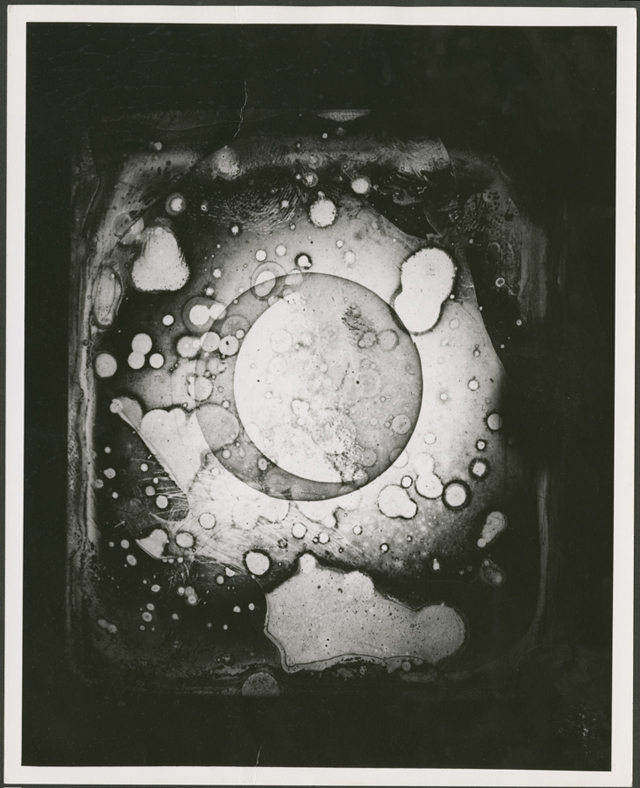 This photograph is believed to be the earliest picture captured of the moon. The mirror-reversed daguerreotype was taken by Josh W. Draper from his rooftop observatory at NYC on March 26, 1840.
This photograph is believed to be the earliest picture captured of the moon. The mirror-reversed daguerreotype was taken by Josh W. Draper from his rooftop observatory at NYC on March 26, 1840. 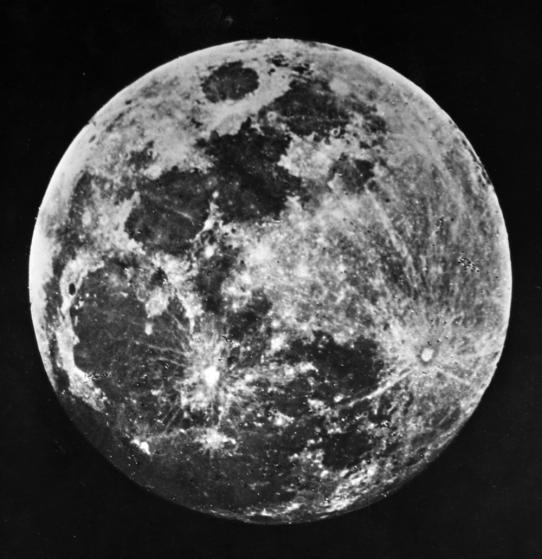 Here is another one of Draper’s early moon pictures. (Photo by J. W. Draper/London Stereoscopic Company/Getty Images). According to this article, Draper wasn’t the first photographer to shoot the moon. Several Frenchmen may have beaten him to it, but he was the first photographer to capture it in any detail. He was also definitely the first to shoot a full moon, so he gets credit for that.
Here is another one of Draper’s early moon pictures. (Photo by J. W. Draper/London Stereoscopic Company/Getty Images). According to this article, Draper wasn’t the first photographer to shoot the moon. Several Frenchmen may have beaten him to it, but he was the first photographer to capture it in any detail. He was also definitely the first to shoot a full moon, so he gets credit for that. 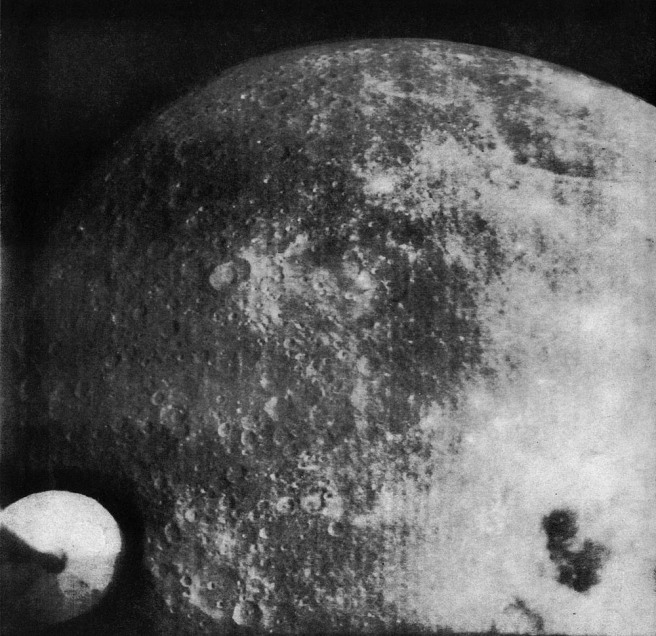 The Soviets beat us to the opposite side of the moon. This picture was captured by Zond-3, the second spaceship to view the far side of the lunar surface. Lots more here.
The Soviets beat us to the opposite side of the moon. This picture was captured by Zond-3, the second spaceship to view the far side of the lunar surface. Lots more here. One of the first pictures of the earth shot from the surface of the moon. Via National Geographic: “This photo reveals the first view of Earth from the moon, taken by Lunar Orbiter 1 on August 23, 1966. Shot from a distance of about 236,000 miles (380,000 kilometers), this image shows half of Earth, from Istanbul to Cape Town and areas east, shrouded in night.”
One of the first pictures of the earth shot from the surface of the moon. Via National Geographic: “This photo reveals the first view of Earth from the moon, taken by Lunar Orbiter 1 on August 23, 1966. Shot from a distance of about 236,000 miles (380,000 kilometers), this image shows half of Earth, from Istanbul to Cape Town and areas east, shrouded in night.”
History of pretty
Because they’re beautiful: Here are three neon love letters.
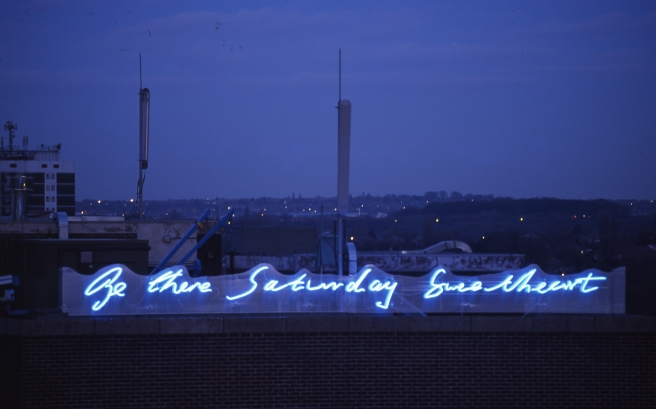
1. Fionna Banner – “Be There Saturday Sweetheart”
This 30-foot-tall neon sign was constructed in 2000 on the top of the New Art Gallery in Walsall, UK. I don’t think it’s there anymore, but I don’t know for sure. What I do know is this: The simple statement comes from the love letters of artist Jacob Epstein to Kathleen Garman. Although she was married to another man when she met Jacob, Kathleen fell in love with the sculptor and eventually left her husband for him. They stayed together until his death. Despite the rocky start (or perhaps because of it?) their letters are filled with sweetness and light. “With you I have every joy and every happiness,” Jacob wrote to his lover. “My nights are my worst time. I lie awake and think of you. Last night, Sunday, was wonderful moonlight and I thought of you, picturing how you were, how fascinating you looked on the balcony beside the lake in the moonlight and the lantern lights… I am always yours Kitty. Be there Saturday sweetheart.” 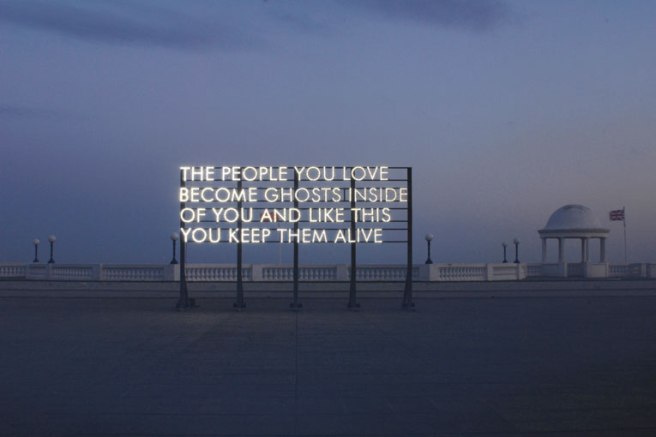
2. Robert Montgomery – “The People You Love”
Truth time: I’m making this list today because I’m in a melancholy mood. I have a migraine hangover and my brain is fuzzy and unwilling to focus. I feel like a ghost of myself. I’m being lazy and wallowing—I’ll admit that.
But don’t let that take away from the art, because all three of these pieces are wonderful, lovely and haunting, modern and retro, sweet and sad. Artist Robert Montgomery created this piece after the death of a close friend. For him, ghosts are a positive force, a way of keeping in touch with the people he has lost. “I find the idea that love can somehow triumph over death an idea I need to keep sane,” he said.
But you know what I really love about this piece? It’s not just the ghost-y-ness or the eerie setting or the sparse and square font. It’s the way it turns light into a metaphor for humanity, for that elusive thing we call the soul or the spirit. Stare at a neon sign, then look away. The afterglow remains, spots on our vision. An imprint of what was. A visual ghost. More than a memory, less than a presence.
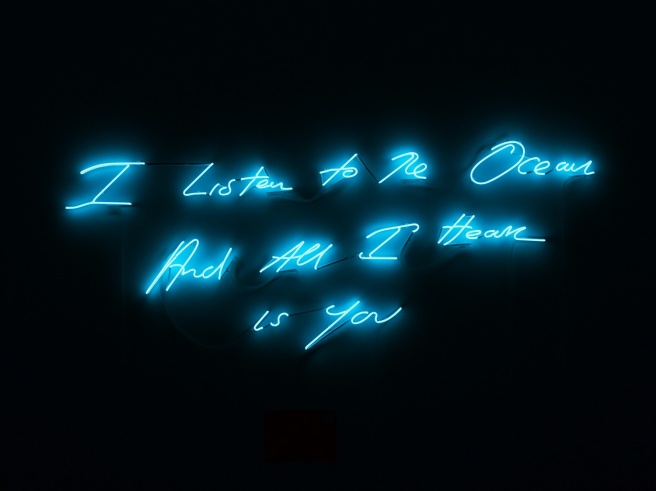
3. Tracey Emin – “I Listen To The Ocean And All I Hear Is You”
I saved my favorite for the finale. I find Tracey Emin so inspiring, both as an artist and as a human being. I love her brash attitude and her feminist message. I love her sensitive, neurotic, erotic works (I stumbled across “Everyone I’ve Ever Slept With” when I was in college and that piece blew my freaking mind). I particularly love her neon ladies, all naked and glowing with legs spread and toes pointed. I would have shared one of those, but I try to keep my blog SFW, so instead here is one of her text-based pieces (another good one reads: “People like you need to fuck people like me”—not as poetic, but pretty damn funny). Emin’s extremely prolific and likes to work with light-up letters, so if you like this as much as I do, you can see more of her work here.
And you know what? After writing all this and doing the work of inserting images and googling details, I find myself feeling much, much better. I think it’s Tracey’s good influence (or I’m just going to pretend that’s it and not the glass-and-a-half of wine I drank while waiting for my internet to catch up to my thoughts). Thanks, lady.
The ultimate mombod.
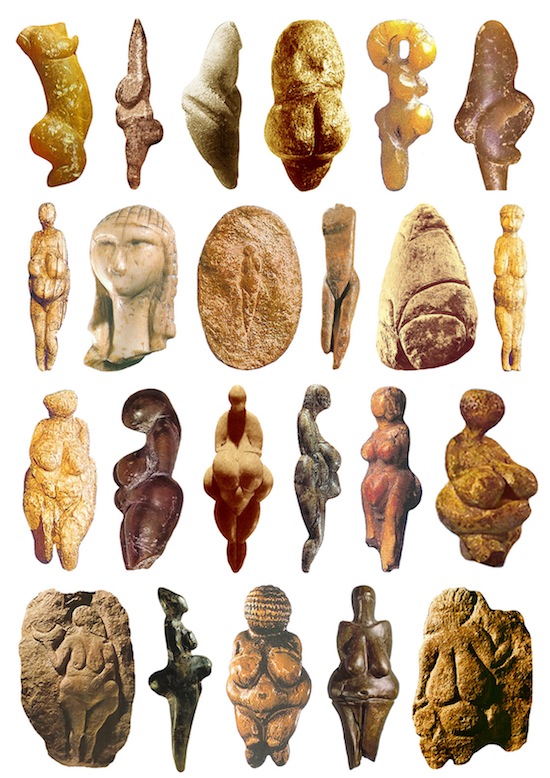 In honor of Mother’s Day (and since my mom reads my blog more than anyone else, probably) here’s a very cool graphic of mombods compiled by the smart ladies at etsi-ketsi. (Don’t know what a “mombod” is? It’s cool, it’s a stupid made-up thing that happened on the internet.)
In honor of Mother’s Day (and since my mom reads my blog more than anyone else, probably) here’s a very cool graphic of mombods compiled by the smart ladies at etsi-ketsi. (Don’t know what a “mombod” is? It’s cool, it’s a stupid made-up thing that happened on the internet.)
It’s also interesting to note that these aren’t all Stone Age sex symbols as some might assume. “Erroneously, perhaps even cynically, many of the statues and sculptures shown here have been named Venus statuettes by patriarchal archeologists, as in Venus of Willendorf and Venus of Laussel; names based on the well-known nude depictions of the much later and slender Roman Venus,” explains scholar Eva Sawada.
Here’s another amazing graphic, this one shows “Goddess Sculptures” from the early Bronze Age. There’s something so amazingly modern about these, so geometric and cool, especially the top row. With their sharp angles and big shoulders, these femmes remind me of 80’s business ladies in power suits. How would you worship a boss-bitch goddess? By burring a pyre of vintage Vogues? By using lipstick as warpaint and reenacting the ancient ritual of the power lunch? By sacrificing your toes to the torture of a pointy heel? One can only imagine.  Anyway, happy Mother’s Day or whatever. Enjoy the history lesson.
Anyway, happy Mother’s Day or whatever. Enjoy the history lesson.
History of Pretty: Albrecht Dürer, the reason I studied art history in the first place.
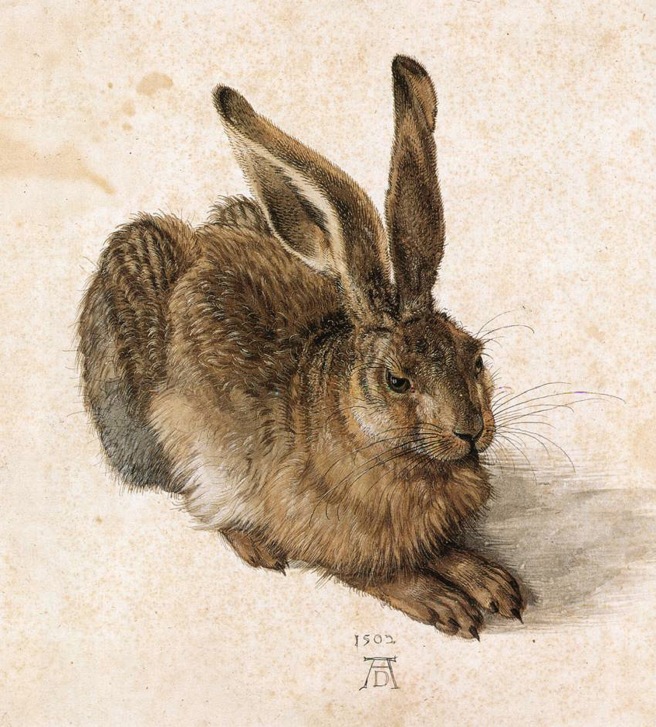 This watercolor paintings, Dürer’s “Young Hare” (or in German, Feldhase), is one of my all-time favorite pieces of art. Painted in 1502, this image is iconic for its insane level of detail. Can you believe that picture is only approximately eight inches wide? Yet somehow, Dürer, that master of precision, was able to create a lifelike image, complete with hair that goes this way and that, and lovely golden undertones that gives the wild rabbit warm vibes.
This watercolor paintings, Dürer’s “Young Hare” (or in German, Feldhase), is one of my all-time favorite pieces of art. Painted in 1502, this image is iconic for its insane level of detail. Can you believe that picture is only approximately eight inches wide? Yet somehow, Dürer, that master of precision, was able to create a lifelike image, complete with hair that goes this way and that, and lovely golden undertones that gives the wild rabbit warm vibes.
Let’s get a bit closer: 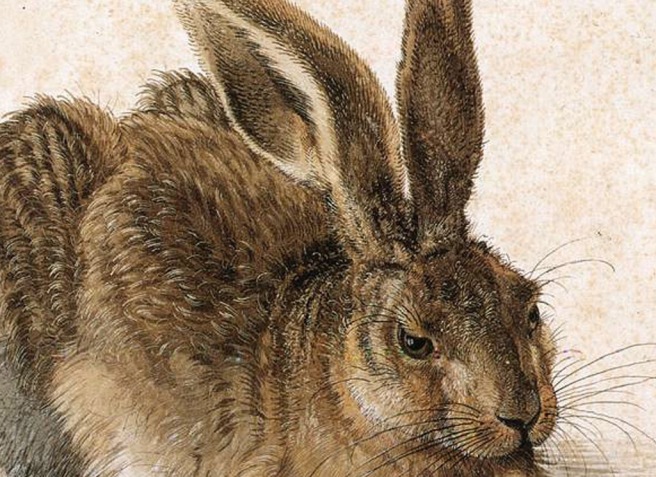 That bunny looks a little mean, if I’m being totally honest. Or perhaps mean isn’t the right word—feral. Wild. But still, I would love to stroke its fur. Continue reading
That bunny looks a little mean, if I’m being totally honest. Or perhaps mean isn’t the right word—feral. Wild. But still, I would love to stroke its fur. Continue reading
The History of Pretty: Ophelia, the girl who just couldn’t catch a break.
Poor Ophelia. Life wasn’t kind to you. And by life, I mean Hamlet—or rather, Shakespeare, because he’s the one who gave you so few lines to speak, so little personality. Faded, lost, mad, drowned. No wonder painters couldn’t stop painting you—who doesn’t love a tragic ingenue? In the words of your brother: “Thought and affliction, passion, hell itself, She turns to favor and to prettiness.”
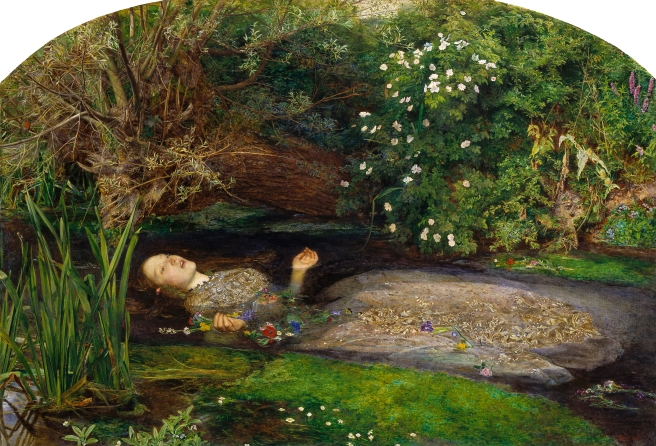 Your youth and beauty made madness appealing and your virginity made it all the more intoxicating. Artists went wild, turning your tragic character into fodder for their romantic paintings. This (above) is perhaps the best known Ophelia image, pained by John Everett Mills in 1852. It even inspired my own flower-bathing experience.
Your youth and beauty made madness appealing and your virginity made it all the more intoxicating. Artists went wild, turning your tragic character into fodder for their romantic paintings. This (above) is perhaps the best known Ophelia image, pained by John Everett Mills in 1852. It even inspired my own flower-bathing experience.
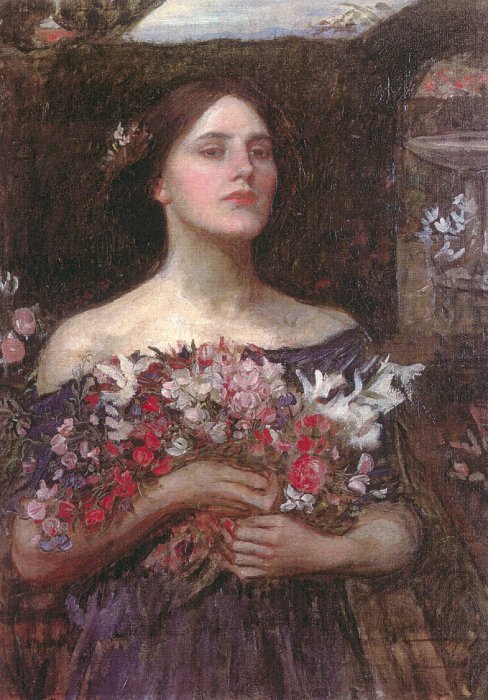
Here is Ophelia looking alive and rosy, holding some posies. I love the expression on her face here—she looks strong, almost defiant. This painting is titled “Gather Ye Rosebuds or Ophelia,” which references both the famous Robert Herrick poem and Shakespeare’s doomed character for a lit nerd double-hitter.
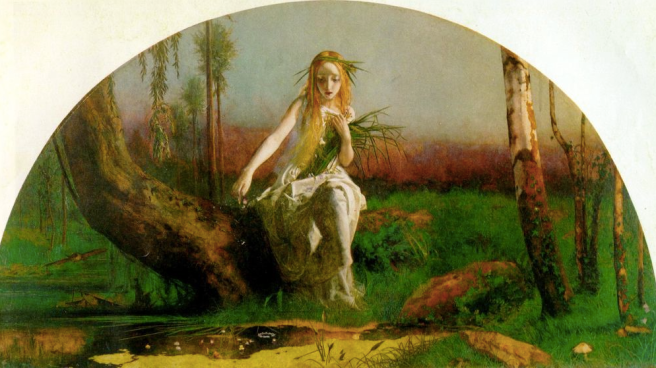
While not as famous as many of the other Ophelia depictions, this painting by Arthur Hughes is my personal favorite. She looks so frail and so childlike. Look at that vibrant, sinister, poisonous green! And the cute little toadstool. I find this piece enchanting and strange in a surprisingly modern way (doesn’t it look like it could be by a contemporary artist?). Also, do you ever wonder why Ophelia is always depicted with flowers? It’s not just because she’s a wilted, fragile symbol of femininity…
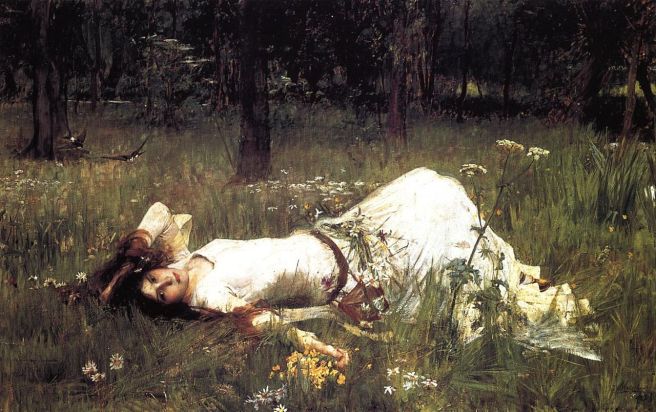
Ophelia had relatively few lines in Hamlet, but her madness is marked by gibbering about flowers, herbs, and their meanings. She sings and babbles to her brother Laertes:
“There’s rosemary, that’s for remembrance. Pray you, love, remember. And there is pansies, that’s for thoughts… There’s fennel for you, and columbines.—There’s rue for you, and here’s some for me. We may call it “herb of grace” o’ Sundays.—Oh, you must wear your rue with a difference.—There’s a daisy. I would give you some violets, but they withered all when my father died.”
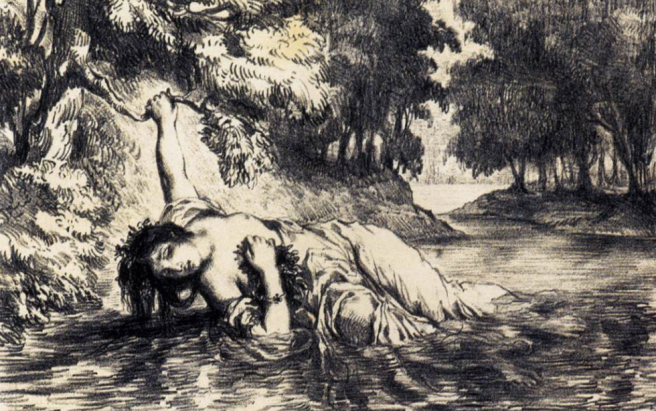
There are some modern renditions of Ophelia, but she seemed to be most popular during the mid-1800s, which makes perfect sense. This was a time of Romanticism and Impressionism, of experimenting with new forms while reawakening old stories.
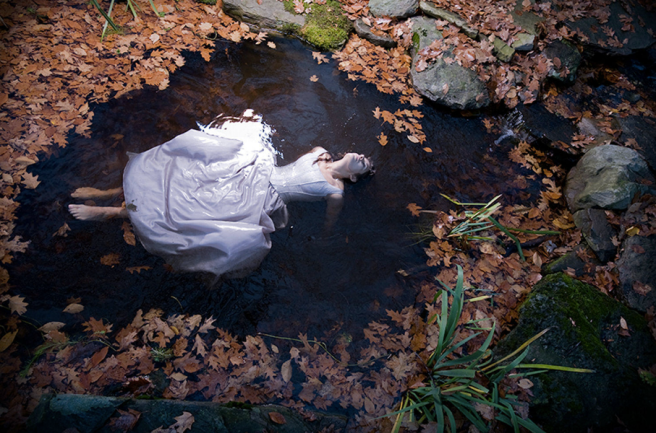
The rich visual language of Ophelia creates an instantly recognizable figure. Who else would be swathed in a white dress, floating in water, surrounded by greenery and flowers? Contemporary artists seem to prefer to photograph Ophelia rather than paint her. It’s an easy shoot to set up, and the results are made all the more dramatic by the literary references. (Plus her fate is really tailor-made for modern feminists, since her madness is predicated by a very real virgin/whore dichotomy set up by her father and her lover. Ouch.)
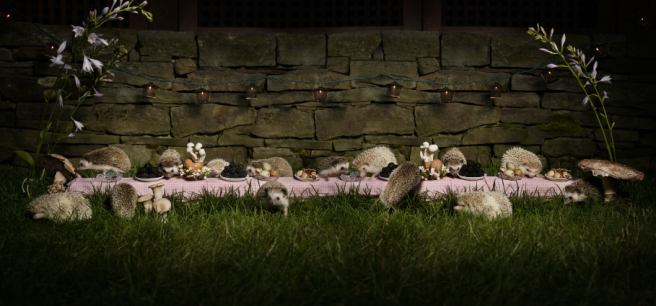 Admittedly, this last picture has nothing to do with Ophelia, except that it was shot by Claire Rosen (same photographer as the one above) and it is gloriously awesome. Rosen has an entire series of Fantastic Feasts with beasts, as well as a series of fairy tale-inspired images. They’re all lovely. Go take a look.
Admittedly, this last picture has nothing to do with Ophelia, except that it was shot by Claire Rosen (same photographer as the one above) and it is gloriously awesome. Rosen has an entire series of Fantastic Feasts with beasts, as well as a series of fairy tale-inspired images. They’re all lovely. Go take a look.
More in History of Pretty:
I love Alphonse Mucha
The most beautiful sculpture I have never seen.
Oh, Louise.
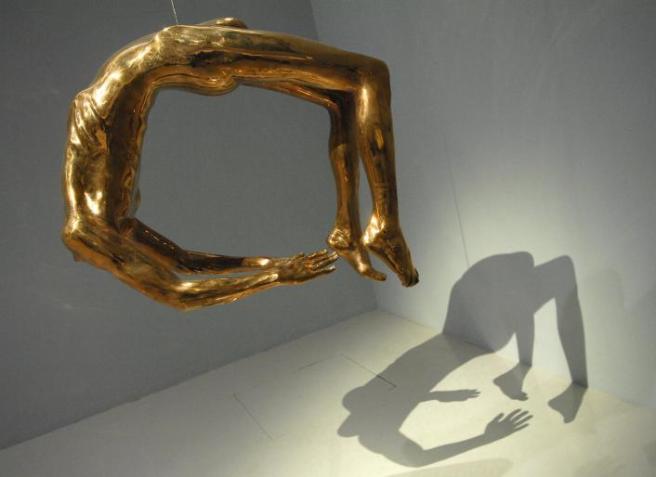 It’s very late and though I have lots to say about Louise Bourgeois (some of which I’ve already said), I’ll keep it short and sweet for now. Here is a picture of her sculpture “Arch of Hysteria.” Like most of her work, it’s scary and eerie and yet…somehow beautiful. To me, it speaks to that feeling of dread that settles in the pit of my stomach after I make a life changing, supposedly freeing move (for further reference, see the ending of The Graduate). This figure is trapped, yet fluid. It’s the combination of anxiety and bravery made physical in a sweeping motion of the human form. It’s how I feel whenever I stand on top of a mountain: terrified, but terribly alive.
It’s very late and though I have lots to say about Louise Bourgeois (some of which I’ve already said), I’ll keep it short and sweet for now. Here is a picture of her sculpture “Arch of Hysteria.” Like most of her work, it’s scary and eerie and yet…somehow beautiful. To me, it speaks to that feeling of dread that settles in the pit of my stomach after I make a life changing, supposedly freeing move (for further reference, see the ending of The Graduate). This figure is trapped, yet fluid. It’s the combination of anxiety and bravery made physical in a sweeping motion of the human form. It’s how I feel whenever I stand on top of a mountain: terrified, but terribly alive.
The History of Pretty: I Love Alphonse Mucha.
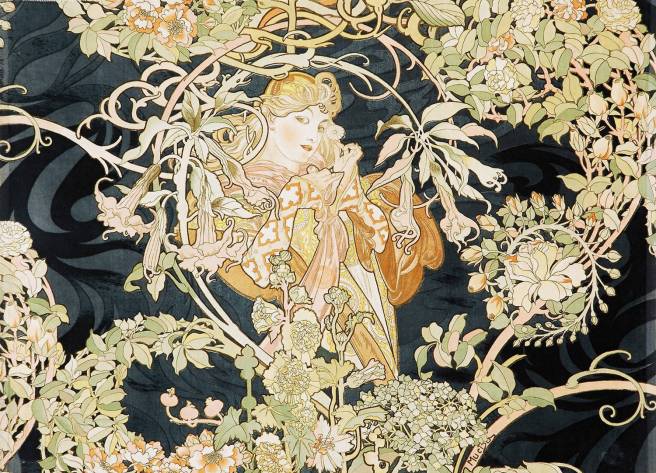 I decided I need a bit more consistency in my posts, so I’m going to start a series where I highlight my favorite artists from history. It’s one part review (I learned so much wonderful stuff in college and then never used it again) and one part blogging exercise. Two parts futile? Perhaps! But does one really need an excuse to look at Mucha’s gorgeous ladies? If your answer is yes, you’re wasting my time, then I really just don’t know why you’re reading my blog.
I decided I need a bit more consistency in my posts, so I’m going to start a series where I highlight my favorite artists from history. It’s one part review (I learned so much wonderful stuff in college and then never used it again) and one part blogging exercise. Two parts futile? Perhaps! But does one really need an excuse to look at Mucha’s gorgeous ladies? If your answer is yes, you’re wasting my time, then I really just don’t know why you’re reading my blog.
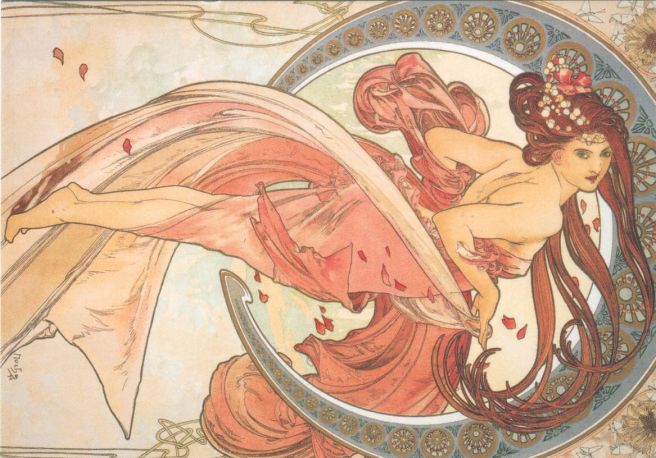 Mucha was a Czech artist who lived during the late 19th, early 20th century. As you can see from his works, he was pretty invested in the whole Art Nouveau thing—in fact, he practically invented this particular poster style, which went on to become immensely popular in fin de siecle Paris. But Mucha was also crazy popular in his motherland. Following his international success at the 1900 Universal Exhibition in Paris, he returned to Prague to create art that he felt was truly reflective of the Czech history and character.
Mucha was a Czech artist who lived during the late 19th, early 20th century. As you can see from his works, he was pretty invested in the whole Art Nouveau thing—in fact, he practically invented this particular poster style, which went on to become immensely popular in fin de siecle Paris. But Mucha was also crazy popular in his motherland. Following his international success at the 1900 Universal Exhibition in Paris, he returned to Prague to create art that he felt was truly reflective of the Czech history and character.
While a lot of people know him for his pretty posters that adorn dorm rooms of quasi-artsy young adults all over the world, I have always loved his pieces that depict the “Czech woman.” He idealized the Czech peasant ladies, with their strong bodies and long, flowing hair. He wanted to capture the spirit of his small country, and he often did this through allegories. Sure, he also did plenty of advertisements, but I’ll never forget seeing pieces from “The Slav Epic” and his seasons series at the Mucha Museum in Prague. While his style is stamped all over the city, from twisty, organic-inspired light fixtures to hand-painted flowering vines that adorn the exterior of an otherwise unremarkable building, it was fascinating to see so much of one artist’s work in one place. I brought home a poster, which has since been crushed and wrinkled out of shape. But I don’t think I’ll ever throw it out.
